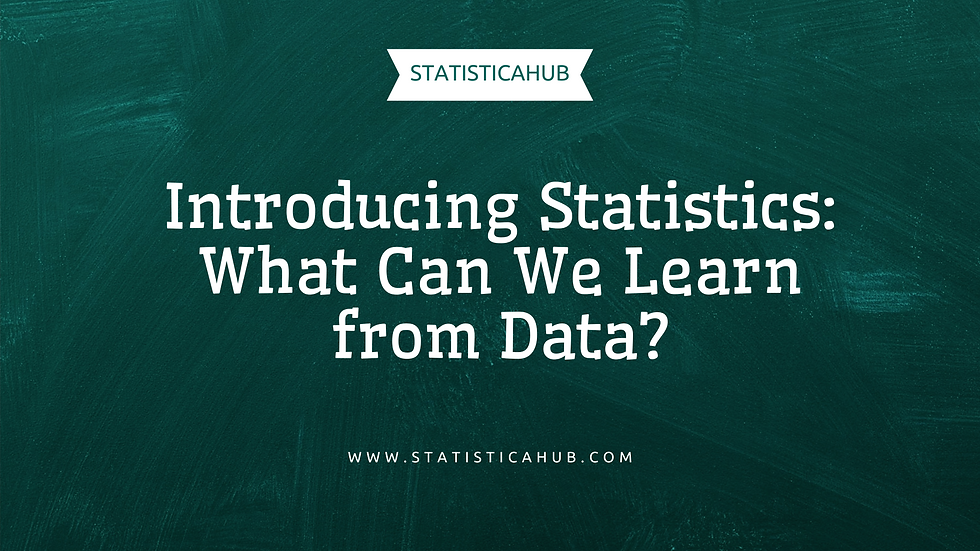1.1 Introducing Statistics: What Can We Learn from Data?
- StatisticaHub
- Dec 8, 2024
- 3 min read
Updated: Dec 9, 2024
AP Statistics: Exploring one variable data

Statistics and Data: Understanding the Basics
Statistics is the science of data, encompassing its collection, organization, analysis, and interpretation. It plays a crucial role in decision-making across various fields. Broadly, the study of statistics is divided into two main branches: Descriptive Statistics and Inferential Statistics.
Descriptive Statistics focuses on summarizing and presenting data in a meaningful way. This involves collecting, organizing, and visualizing data through tables, graphs, and summary measures like averages.
Inferential Statistics, on the other hand, aims to draw conclusions about a larger population based on data sampled from it. This branch involves generalization, estimation, hypothesis testing, and prediction.
This discussion will focus on descriptive statistics, leaving inferential methods for a later stage.
Data and Context: Adding Meaning to Numbers
Imagine a statistics class where a teacher records the test scores of her students. These scores constitute data—numerical or categorical information gathered for analysis. A data set includes all the observations collected during this process. However, raw data lacks meaning unless it is placed in context.
Understanding the data's context answers key questions like what, who, when, where, why, and how. For instance, knowing that the numbers represent test scores of students in a particular class can reveal insights into student performance, test difficulty, or even teaching effectiveness.
Key Terminology
Element: The individual entities (e.g., students) from whom data are collected.
Observation: A single data point, such as a student's test score.
With a large dataset, it becomes challenging to glean insights directly. Descriptive statistics addresses this by organizing the data into tables, visualizing patterns through graphs, or summarizing central tendencies with measures like the mean.
Diving into the "W"s of Data Analysis
To fully understand data, statisticians often rely on the "W"s:
1. Who: Identifying the Source
The "who" describes the entities involved in generating the data. These entities, often referred to as cases, can vary widely:
Respondents: Individuals who provide information through surveys.
Subjects or Participants: Individuals involved in experiments where treatments are applied.
Experimental Units: Non-human subjects, such as animals, plants, or objects.
Understanding who contributed to the data helps define the scope and applicability of the analysis. For example, results from a study conducted on college students may not generalize to the broader population.
2. What: Understanding Variables
Variables are characteristics or attributes measured or observed for each element in the dataset. They are broadly classified as:
Dependent Variables: The outcome being measured.
Independent Variables: Factors manipulated to observe their effect on the dependent variable.
Controlled Variables: Factors kept constant to eliminate their influence.
Carefully defining and measuring variables ensures the validity and reliability of any analysis.
3. When and Where: The Context of Data Collection
The "when" and "where" describe the time and location of data collection. Both factors can influence the results:
When: Time-specific factors may introduce trends or patterns (e.g., seasonal variations).
Where: Geographical or cultural context can shape the data, affecting its interpretation.
4. Why: Defining the Purpose
The "why" addresses the objective behind the data collection. For example, investigating the relationship between sleep hours and test scores involves questions like:
Is there a relationship between these variables?
What is the nature of the relationship (positive, negative, or none)?
Is the observed relationship statistically significant?
Such questions guide the analysis and help draw meaningful conclusions.
5. How: Data Collection Methods
The "how" refers to the methods used to collect data, such as surveys, experiments, observations, or secondary data sources. Each method has strengths and limitations:
Surveys: Cost-effective for large populations but may suffer from response biases.
Experiments: Provide controlled environments but require careful design to ensure validity.
Selecting an appropriate method is critical to maintaining the quality and reliability of the dataset.
The Role of Descriptive Statistics
Descriptive statistics bridges raw data and actionable insights. By constructing tables, visualizing data through graphs, and summarizing it using measures like averages or standard deviations, we gain a clearer understanding of the dataset. These methods also lay the foundation for inferential statistics, where we draw broader conclusions about populations.
Key Takeaways
Descriptive Statistics: Summarizes and organizes data for clarity.
Context: Answering the "W"s ensures meaningful interpretation.
Variables and Observations: Precise definitions are essential for robust analysis.
By mastering these foundational concepts, statisticians can transform complex datasets into coherent, actionable insights. The subsequent sections will delve into techniques for organizing, visualizing, and summarizing data.

Comments